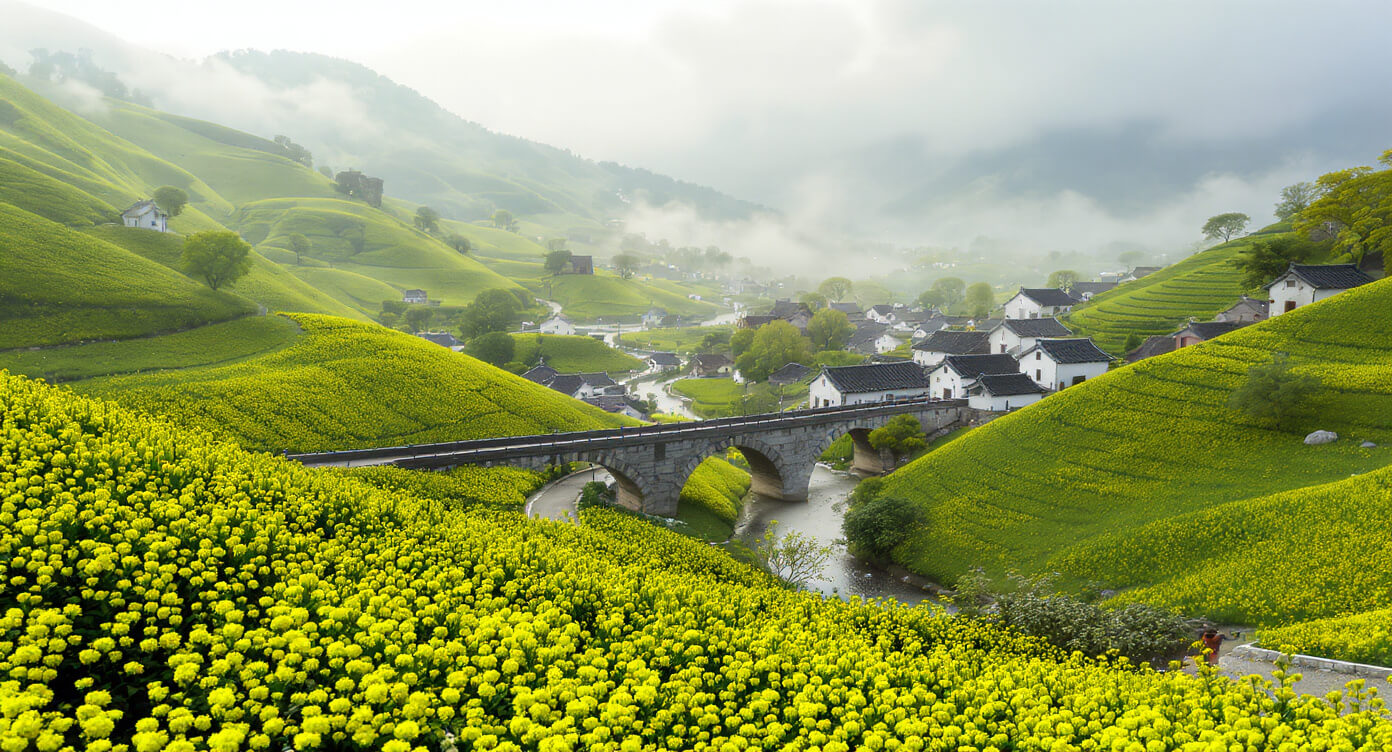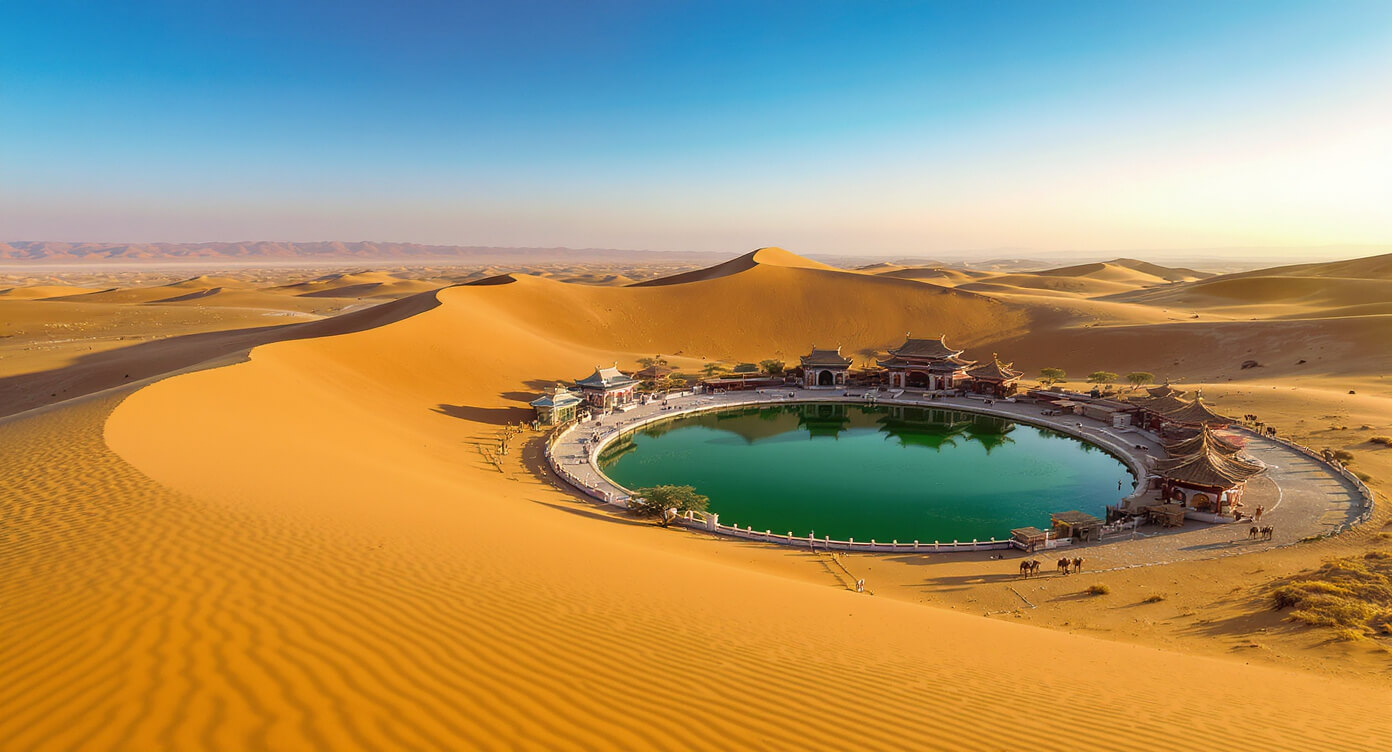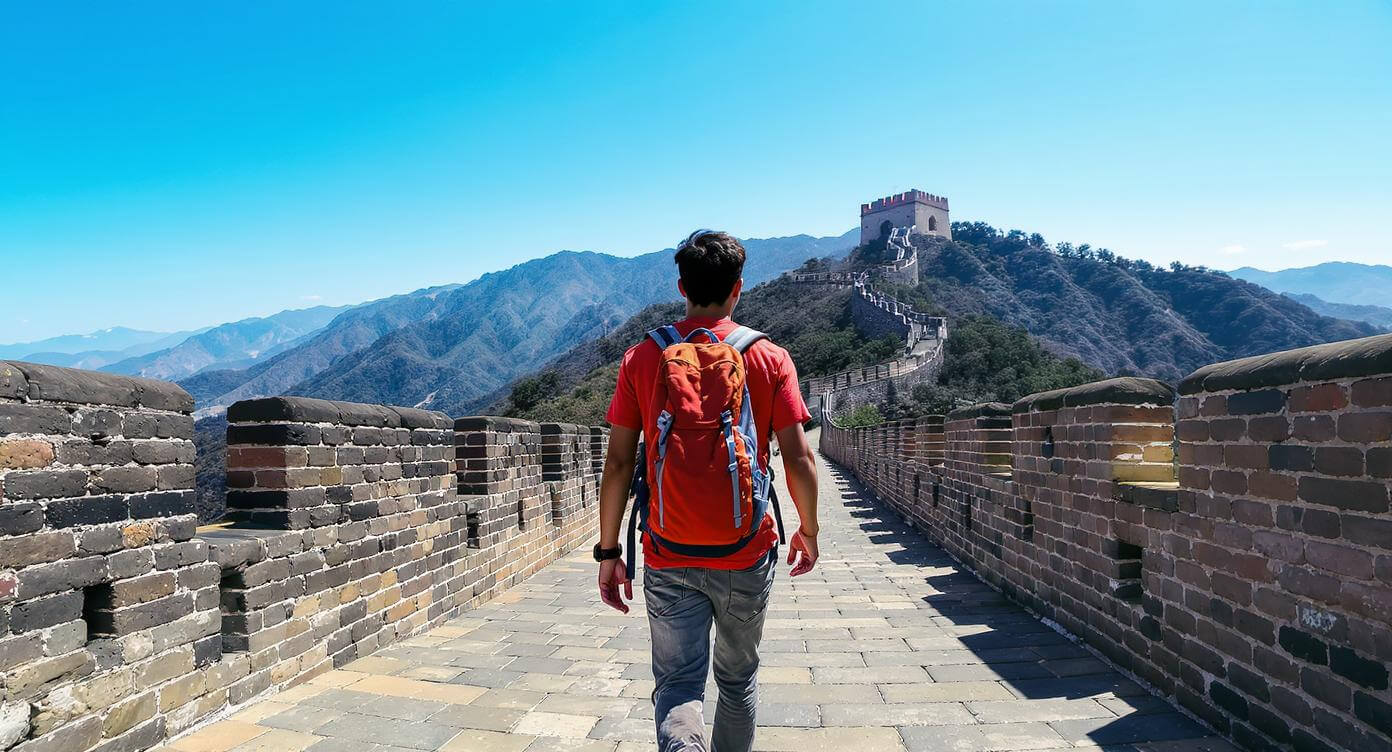Travel eSIMs you may like:
Underrated Places to Visit in China You (Probably) Haven’t Heard Of Yet
Think you know China?
Think again.
Beyond the iconic landmarks, like the buzzing skylines of Shanghai or the Summer Palace in Beijing, lies a version of China not many tourists like yourself get to explore.
Yes, China is massive, so you'll have to carefully plan out your route if you want to hit as many stops on your bucket list as possible. But between the incredible views, the food, and local charm, taking the path less travelled is absolutely worth the extra hassle!
Read on to discover some of the most underrated places to visit in China you'll definitely want to make a detour for.

The Rolling Hills of Wuyuan, Jiangxi Province
Tucked away in Jiangxi Province lies Wuyuan County, where you'll find some of China's most beautiful rolling hills and ancient villages. If you're a photographer or tea-lover, this is without a doubt the region for you.
What to Explore When You Visit
Notable villages to visit in Wuyuan include Likeng, Xiaoqi, and Qingyuan. Here, you'll find stone bridges, wooden alleys, and family-run teahouses that have been serving tea for centuries.
If you want to get fully immersed in the culture, look for a local tea workshop where you'll learn all about the ancient green tea traditions in Wuyuan. You can also explore the Huizhou-style architecture in the region, with its intricate wooden carvings and courtyards. And if you really want to make your Instagram grid the envy of all your followers, visit in spring (early March to mid-April) to capture the area in full bloom.
Mingsha Shan & Crescent Moon Spring, Dunhuang (Gansu)
Where else on the planet can you take a sledge down a dune and then sip tea by an ancient oasis? This remote corner of Gansu offers adventure, serenity, and a timeless connection to the Silk Road trade route.

A Desert Oasis Wonderland
In the heart of Gansu Province lies a rare combination of desert and water: Mingsha Shan, also known as the "Singing Sand Dunes". Here, right in the middle of the dunes, you'll find the Crescent Moon Spring - a perfectly curved freshwater oasis that's existed for over a thousand years. This area was also once a key stop on the Silk Road, adding a layer of history and mystique to this destination.
Unique Activities
There's actually quite a lot to do in this desert oasis. You can ride camels, climb dune peaks, or try your hand at sandboarding. If that's not your thing, just stay at the Crescent Moon pavilion and take it all in with a cup of tea. This is a once-in-a-lifetime kind of pitstop, and the views really are breathtaking.
The Central Asian Cultural Hub at Kashgar, Xinjiang
Kashgar feels like it's worlds away from the Chinese capital and the bigger cities of China. Instead of the high-speed trains, skyscrapers, and colonial-era architecture, you'll find bustling bazaars, mosques, and friendly locals with Uyghur hospitality. If you love history and architecture, Kashgar is a detour into China's far west you've just got to make.
Why It Stands Out
Kashgar was once a thriving pitstop along the ancient Silk Road. Today, it's still a vibrant intersection of Uyghur traditions, Islamic architecture, and Central Asian customs. Walking around, you'll see market stalls very similar to what you would find in places like Morocco or Egypt, making it such a unique and special place to visit on a trip to China.
Must-Do Experiences
The best place to start a visit to Kashgar is at the Kashgar Sunday Market. This is a sprawling bazaar where you'll see livestock, spices, fabulous food, and elaborate textiles on display. After you've hit the market, wander through the Id Kah Mosque, which is one of China's largest Islamic prayer halls, beloved for its ornate tilework and central courtyard, called the Sahan.
As you walk around, you'll pass by narrow alleyways with traditional teahouses where you can try sweet, milky tea and local street food.
Chongqing’s Ancient Town Along the World's Third-Longest River
Near the Yangtze River (which happens to be the world's third-longest river) in Chongqing lies Ciqikou. Ciqikou is like a living snapshot of traditional Chongqing life. Despite its location within the busy city of Chongqing, this lesser-known neighbourhood offers a refreshingly slow-paced escape to the past.
Going Back in Time
Ciqikou Ancient Town was once a hub for porcelain production during the Ming and Qing dynasties. But today, it offers tourists a more relaxed alternative to Chongqing's busy downtown. With its cobbled streets, red lanterns, and unique architecture, you'll feel like you've taken a step back in time on your visit.
Hidden Delights
After you've spent some time wandering around, see if you can find the town's historic porcelain kilns. Many of the kilns are hidden behind teahouses or artist studios, so you have to look closely for them. Another interesting experience you won't want to miss is a Sichuan opera performance, which is famous for its traditional music and bold, colourful costumes.
And if you really, really need a break from city life, take a bamboo riverboat cruise along the Jialing River for the most peaceful view of Chongqing.
Wandering Between the Clouds in Mount Fanjing, Guizhou
Mount Fanjing, located in Guizhou Province, is utterly breathtaking. This UNESCO World Heritage Site is both a sacred Buddhist mountain and a haven for hikers and nature-lovers.
Spiritual Peaks
What makes Mount Fanjing so special is the Buddhist temple (the Red Clouds Golden Summit) that sits at one of the highest points. To reach it, you’ll have to ascend hundreds of steps that spiral through cliffs and clouds.
There is a daily ticket limit, so make sure to book in advance if this is something you want to do. Booking is easiest if you have a ZenSim China travel eSIM, so you don't have to rely on hot spots or unreliable Wi-Fi at your hostel.
Gannan Tibetan Autonomous Prefecture, Gansu
If you’re dreaming of experiencing Tibet but need a more accessible route, Gannan is your answer. This region is deep-rooted in Tibetan tradition and culture, but without the travel restrictions you tend to find in southern China.
A Slice of Tibet With Your Chinese Visa
Gannan offers a taste of Tibetan culture without actually needing to venture into Tibet, which can be tricky.
The town of Labrang is home to one of the six great monasteries of the Gelug School of Tibetan Buddhism. And if you walk the kora at Labrang Monastery (i.e. the pilgrim path), you can walk alongside monks, worshippers, and fellow tourists also looking to experience this incredible tradition.
Climb Jianglang Mountain in Zhejiang
The three iconic peaks of Jianglang Mountain look like a scene from a Chinese storybook. This is definitely a spot to add to your itinerary if you absolutely love to hike (and absolutely hate crowds).
A Geological Wonder That's Off the Beaten Path
Jianglang Mountain is a UNESCO World Heritage site that's hidden in western Zhejiang Province. Jianglang is often overlooked by tourists in favour of more famous destinations in China, like Mount Everest, the Great Wall, or the Forbidden City. However, Jianglang is equally awe-inspiring and much, much quieter, which is a welcome benefit given how busy tourist attractions in China can be.
Take a Day Trip to Zhangjiajie National Forest Park in Zhangjiajie
Located in Hunan Province, Zhangjiajie National Forest Park is one of several national parks in China worth visiting. And, fun fact, it also inspired some of the landscapes for the film, Avatar.
Things to Do
When you arrive at Zhangjiajie National Forest Park, take a moment to walk around and take in all the incredible scenery and nature. You can then make your way to the famous glass-bottom bridge that extends across Zhangjiajie Grand Canyon. You can also take the Bailong Elevator, which is the world's tallest outdoor lift or hike the forest trails for some of the most incredible panoramic views in the world.
Don't Miss the Great Wall of China
No trip to China is complete without walking along the Great Wall. Yes, you've probably (okay, definitely) heard of it before, but you don't have to hit the tourist spots if you want to see it.
Where to Go
The Great Wall stretches over 13,000 miles across the northern border of the country, so there are plenty of opportunities to see it, depending on your itinerary and how you plan your route.
The most popular section of the wall to visit is Badaling, which is easy to access from Beijing. If you'd prefer a quieter experience, head to Mutianyu or Jinshanling. This section of the wall weaves through mountains and forests, providing you with unique photo opportunities you may not see in other stretches of he wall.
Another Wall You Don't Want to Miss When You Visit China: the Xi'an City Wall
While the Great Wall gets most of the attention, the Xi’an City Wall, constructed during the Ming Dynasty, is also a must-see in its own right. This wall is one of the oldest and best-preserved city walls in China, dating back to the 14th century.
Stunning Views and Terracotta Warriors
The entire structure spans nearly 14 km and is completely walkable (and cyclable). As you venture around the wall, you'll have an elevated view of the old city of Xi'an, which is one of China's Four Great Ancient Capitals that also served as the eastern start point of the Silk Road.
Given the city's rich history, it only makes sense that this unique place is chock-full of sightseeing opportunities. Key spots you won't want to miss in Xi'an City include the terracotta warriors (located in the Lintong District) and the Muslim Quarter (located near the Drum Tower).
The Guardian Towers (Kaiping Diaolou) in Kaiping, Guangdong Province (South China)
The Guardian Towers, known locally as "Kaiping Diuaolou", are unlike anything else in China. The towers were originally built by overseas Chinese returning home from abroad, so the structures have this unique blend of Western and southern Chinese design.
Explore by Bike or on Foot
The best way to explore the area around the towers is at your own pace. You could rent a bike and follow the countryside lanes, taking in views of the towers from all different angles. The towers themselves, along with the surrounding village, are a UNESCO World Heritage Site, so it's worth spending quite a bit of time exploring the area and learning about the history.
Embrace City Life in Guangdong Province
The Guangdong Province itself is known for being a cultural and economic hub of southern China. At the heart of the region is the Pearl River Delta, which is one of the most densely populated regions in the world.
This is the region where you'll find some of China's megacities, like Guangzhou and Shenzhen. This is also the region to embrace all the Cantonese cuisine you can find, like dim sum, char siu pork, and wonton noodles. And if you need help translating menus on the fly, make sure to have your travel eSIM downloaded ahead of time so you can order all the outrageously delicious Cantonese food you've always wanted to try.
Other Less-Travelled Spots in China Worth Exploring
If you need a few more destinations to fill up your itinerary, here are a few more not-so-touristy places to visit in China.
- Li River - located in northeastern Guangxi.
- Shilin Stone Forest - located in Yunnan Province.
- Tiger Leaping Gorge - located in Yunnan Province.
- Shamian Island - located in Guangdong Province.
- Sunlight Rock - located in Fujian Province.
Practical Tips for Off-Beat Travel in China
Venturing off the tourist trail in China can be incredibly rewarding. But it's important to plan ahead and leave room for some flexibility. Remote towns and natural sites often have limited infrastructure and some language barriers, so going fully-prepared is an absolute must.
Transportation Between Remote Regions
Travelling to China’s lesser-known destinations often means navigating a mix of regional flights, high-speed trains, and local transportation. Major cities, like Shanghai and Beijing, are well-connected. However, smaller towns and more scenic areas with natural attractions may require a tour or rental car.
Language and Communication Tips
In these under-the-radar regions of China, it may be difficult to find locals who speak English (even at guesthouses and tourist shops). Having a translation app on your phone with internet access (using a travel eSIM, of course) will be an immense help for navigating rural regions. It's also good to have a few Mandarin phrases up your sleeve for basic communication with locals.
Cultural Considerations
China’s rural and minority regions each have their own unique customs that may not be covered in Chinese travel guides. For example, in Tibetan or Uyghur areas, it's important to read up on local traditions, dress modestly, and try not to attract too much attention to yourself. It's also important to be mindful of photography rules, as photography may not be permitted inside gilded temples, shrines, or monuments.
Your Unforgettable Journey in China Few Tourists Get to See
Venturing beyond China's famous landmarks may take a little extra legwork, but it'll be one of the most fulfilling trips of your life.
So embrace your sense of adventure, brush up on a few Mandarin phrases, and don’t forget to download your travel eSIM before you leave, because the real magic of China happens far, far away from the main attractions.
Travel eSIMs you may like:

Written by Holly Grace Callis
Freelance content writer, a big fan of spicy margs.
Holly is our resident digital nomad making the beaches of Mexico home. You’ll usually find her somewhere in LatAm furiously typing about hidden Europe spots or how to wrangle more data from your e-sim deal. After all, it’s not nomad life if you can’t post it on the ‘gram.
Let's connect on LinkedIn 👉
Get amongst it
Join the community
We will reach out when we launch new products, about our sustainability projects, specials, new innovations or maybe even cool sh*t we think is inbox worthy.




